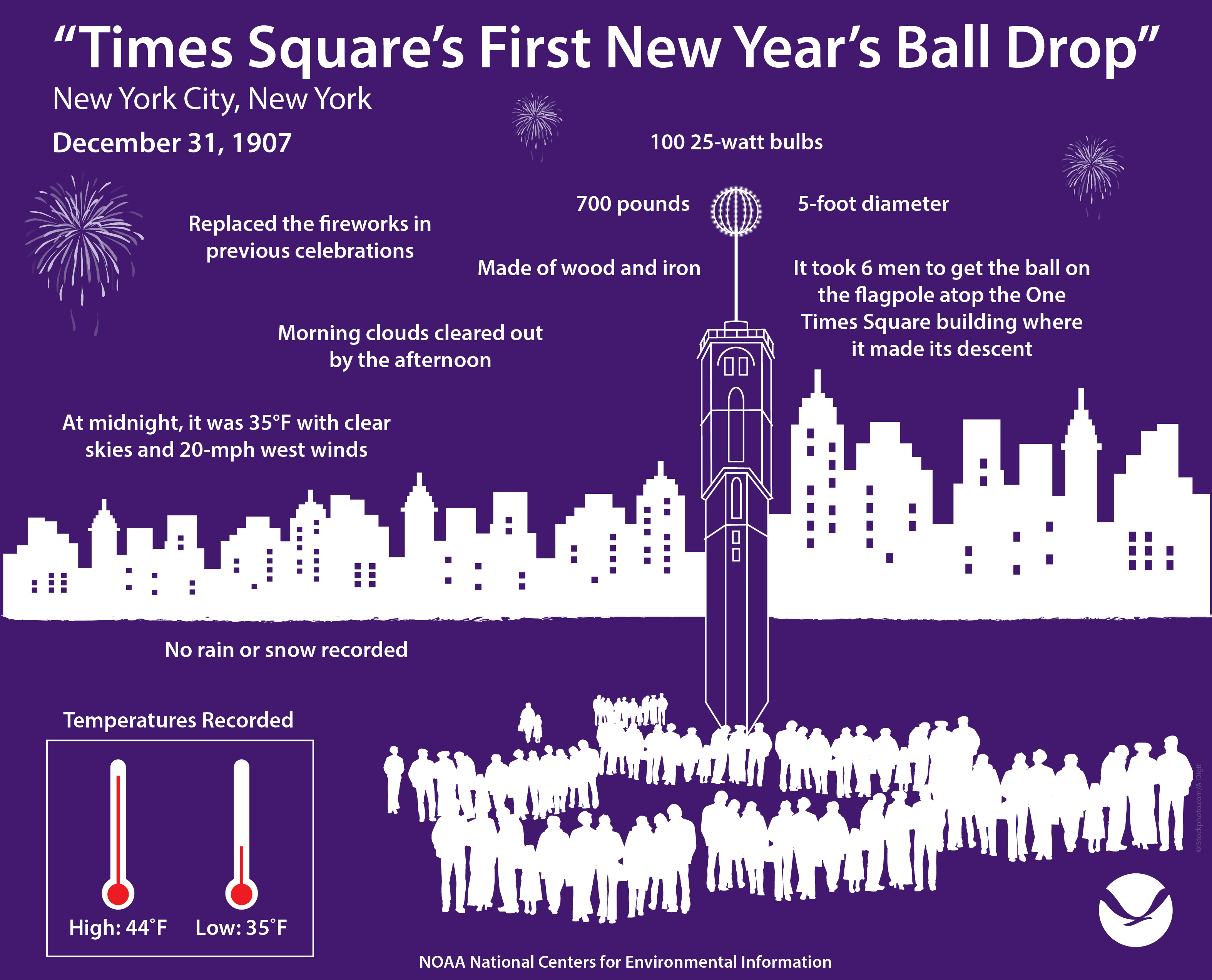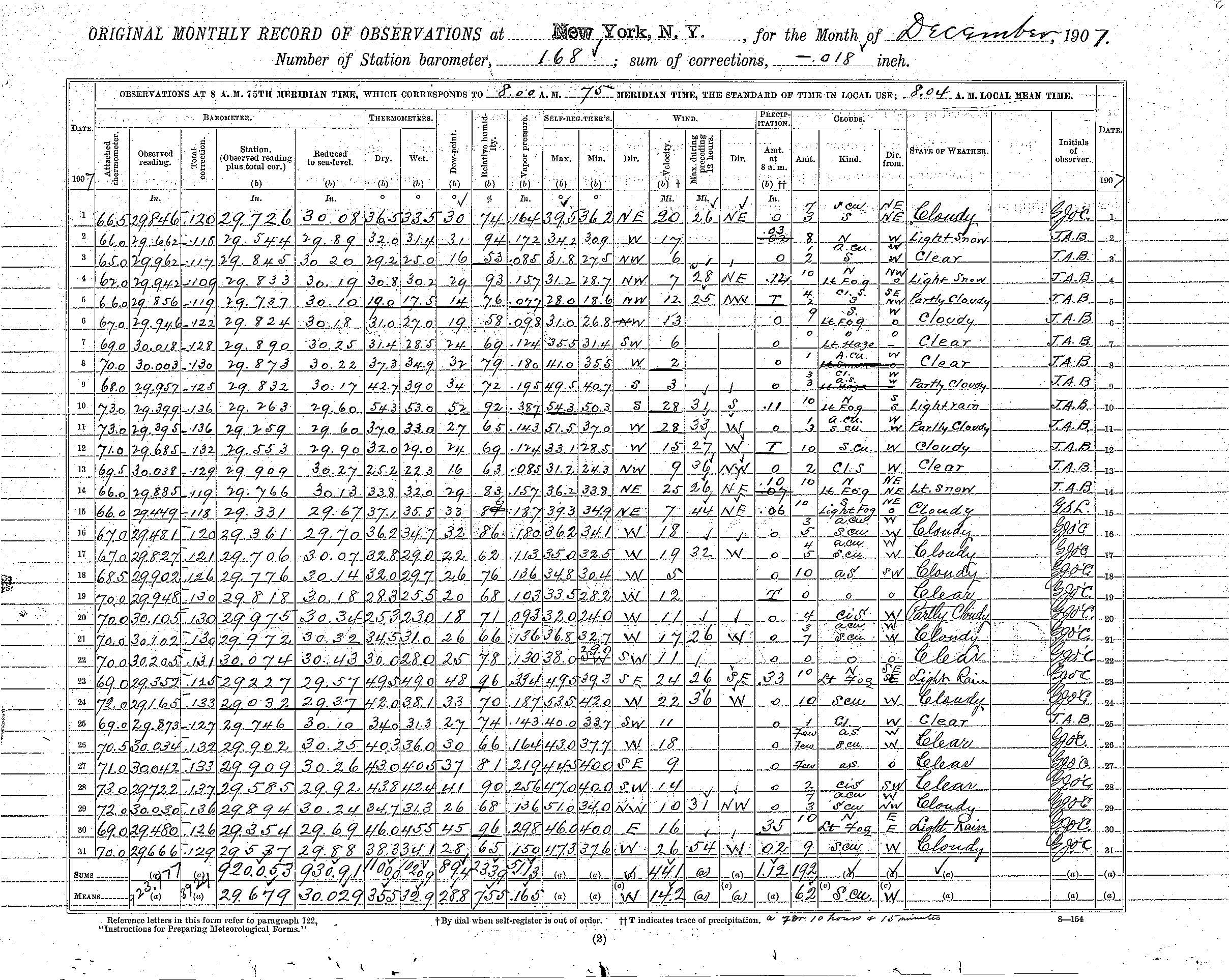A Look Back to the Weather on the First NYC Ball Drop 110 Years Ago
Special Stories
3 Jan 2018 2:07 PM
From NOAA NCEI
For over a century, people across the globe have traveled to the heart of New York City on December 31 to watch a magnificent illuminated ball drop as they ring in the New Year. December 31, 1907, marked the very first ball drop in Times Square at the intersection of Broadway, Seventh Avenue, and 42nd Street. A similar ball drop at the Royal Observatory in Greenwich, England—which originally helped ship captains synchronize their chronometers—inspired the Times Square ritual.
 The ball served as a replacement for the fireworks set off in celebrations of previous years. Covered in 100 25-watt light bulbs, the ball was made of wood and iron, was five feet in diameter, and weighed in at 700 pounds—a mere fraction of the current 12-foot, 11,875-pound ball that will ring in the new year in Times Square. Despite its small size in comparison to today’s ball, it took a team of six men to place the ball on a flagpole atop the One Times Square building, where it made its debut descent.
The ball served as a replacement for the fireworks set off in celebrations of previous years. Covered in 100 25-watt light bulbs, the ball was made of wood and iron, was five feet in diameter, and weighed in at 700 pounds—a mere fraction of the current 12-foot, 11,875-pound ball that will ring in the new year in Times Square. Despite its small size in comparison to today’s ball, it took a team of six men to place the ball on a flagpole atop the One Times Square building, where it made its debut descent.
 Luckily for the spectators who crowded into the Square, December 31, 1907, turned out to be rather nice weather-wise. Despite starting out cloudy, skies cleared in New York City by the afternoon. The day saw a high temperature of 44°F and a low of 35°F, which was relatively warm compared to the current normal high of 40°F and low of 28°F for December 31. No rain or snow was recorded that day. But as the ball lowered at midnight, spectators were definitely in need of their winter coats as the 35°F temperature felt quite cool due to 20-mph west winds.
Edited for WeatherNation by Meteorologist Mace Michaels
Luckily for the spectators who crowded into the Square, December 31, 1907, turned out to be rather nice weather-wise. Despite starting out cloudy, skies cleared in New York City by the afternoon. The day saw a high temperature of 44°F and a low of 35°F, which was relatively warm compared to the current normal high of 40°F and low of 28°F for December 31. No rain or snow was recorded that day. But as the ball lowered at midnight, spectators were definitely in need of their winter coats as the 35°F temperature felt quite cool due to 20-mph west winds.
Edited for WeatherNation by Meteorologist Mace Michaels
 The ball served as a replacement for the fireworks set off in celebrations of previous years. Covered in 100 25-watt light bulbs, the ball was made of wood and iron, was five feet in diameter, and weighed in at 700 pounds—a mere fraction of the current 12-foot, 11,875-pound ball that will ring in the new year in Times Square. Despite its small size in comparison to today’s ball, it took a team of six men to place the ball on a flagpole atop the One Times Square building, where it made its debut descent.
The ball served as a replacement for the fireworks set off in celebrations of previous years. Covered in 100 25-watt light bulbs, the ball was made of wood and iron, was five feet in diameter, and weighed in at 700 pounds—a mere fraction of the current 12-foot, 11,875-pound ball that will ring in the new year in Times Square. Despite its small size in comparison to today’s ball, it took a team of six men to place the ball on a flagpole atop the One Times Square building, where it made its debut descent.
 Luckily for the spectators who crowded into the Square, December 31, 1907, turned out to be rather nice weather-wise. Despite starting out cloudy, skies cleared in New York City by the afternoon. The day saw a high temperature of 44°F and a low of 35°F, which was relatively warm compared to the current normal high of 40°F and low of 28°F for December 31. No rain or snow was recorded that day. But as the ball lowered at midnight, spectators were definitely in need of their winter coats as the 35°F temperature felt quite cool due to 20-mph west winds.
Edited for WeatherNation by Meteorologist Mace Michaels
Luckily for the spectators who crowded into the Square, December 31, 1907, turned out to be rather nice weather-wise. Despite starting out cloudy, skies cleared in New York City by the afternoon. The day saw a high temperature of 44°F and a low of 35°F, which was relatively warm compared to the current normal high of 40°F and low of 28°F for December 31. No rain or snow was recorded that day. But as the ball lowered at midnight, spectators were definitely in need of their winter coats as the 35°F temperature felt quite cool due to 20-mph west winds.
Edited for WeatherNation by Meteorologist Mace MichaelsAll Weather News
More